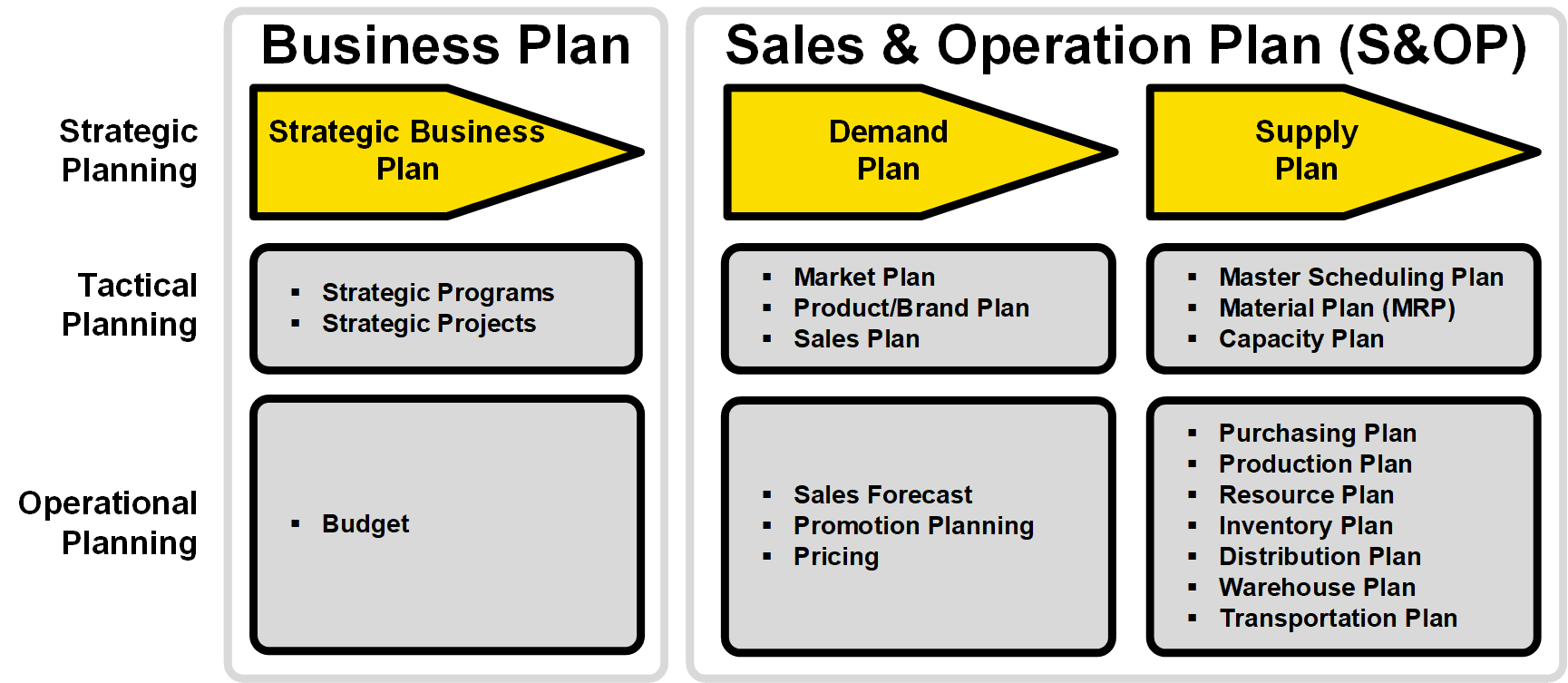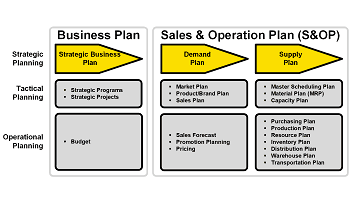A strategic plan without a strong strategy execution is just a “dream.” We are living in a very turbulent business environment, in which crafting the right strategy is a key activity in the company growth and profitable journey. However, crafting the right strategy doesn’t guarantee the strategy will work. It is well known that many of the strategies that fail are as a result of poor strategy execution. Many organizations have strategic plans and annual business plans (budgets) in place. Nevertheless, the experience said that annual budgets are not enough to success on strategy execution. Thus, let see how we can accelerate and improve the strategy execution using the Sales & Operations Planning (S&OP) – Note: Be aware that some people rename this tool as Integrated Business Planning.
Why the Sales & Operations Planning (S&OP)?
- The reality says that in companies that don’t have a S&OP process in place, the two core functions of the firm Demand and Supply use to run their own and different plans. The misalignment of the Demand and Supply functions increase the total cost structure of the firm (higher inventory costs, lower productivity, emergency cost raising, etc.), reduce the service level to end customers (stockout, delays, etc.) and last but not least, deteriorate the competitive position of the firm. But the situation uses to be even worse in medium and large firms because the Demand function uses to be divided up to three departments (product/brand, marketing, and sales). The same it’s happening with the Supply function that uses to be divided up to three departments (purchasing, production, and logistics). So, one of the main deliverables of a S&OP is having one version of the truth, I mean one unified plan in which all the main areas of the company are fully aligned. This is so important because any issue at the planning level will amplify the problems at the tactical and operational levels.
- Nowadays, we have a high customer expectations which are difficult to match. The monthly S&OP process is building a more agile and responsive organization which can optimize the use of inventory and other resources, and improve customer service at the same time.
- Companies with internal plans misaligned use to spend much time and energy fighting internally (marketing vs. sales or demand vs. supply) and blaming each other. Another deliverable of a S&OP is to minimize the internal frictions, and secure the firm energy to increase market share and work internally to improve the company.
- Likely the root cause of firms underperforming or “satisfactory” underperforming (doing just fine) use to be a lack of coordination between the Demand owners and the Supply owners. Communication between those areas used to be poor with many unplanned events that cost a lot of money to the company, and damage the quality of the products and services. Again, the S&OP process is solving that issue establishing a few planned and coordinated meetings every month with the right people involved.
- Another characteristic of firms underperforming is that they are struggling with the present. Their processes are not well optimized, so those firms are more focused on solving the issues of the short-term (3 to 4 months) rather than planning the future. However, the lack of planning and visibility after 3 to 4 months doesn’t allow the firm to proactively anticipate future market trends or company constraints. Organizations that are struggling with the present should solve their short-term issues, but in parallel they should invest in developing a S&OP process that will reduce the chaotic and costly unplanned events.
- It is well accepted that nowadays efficient and market-driven companies are supported for cross functional processes. However, cross functional processes are not working just because there is a quality document that shows the link between different areas. To really make cross functional processes work, organizations need to build high performance cross functional teams that take business decisions rather than functional ones. One of the foundations of S&OP is the creation of those cross functional teams (Demand team, Supply team, Pre-S&OP team, and the Executive team) with regular meetings and change management techniques in place to work as one team with one unified plan. Those high performance teams should have the following goals: planning, performance measurement, accountability, continuous improvement, and bottom-up feedback.
- Last but not least, firms with a poor strategy execution used to fail to achieve their goal of defining the company direction. A poor strategy execution creates confusion and lack of truth in the Leadership team. Nevertheless, the S&OP will strongly support the strategy execution. First, the S&OP process starts with the input of the Strategic Business Plan which guarantee the integration between both plans. Second, the S&OP is a link between the long-term Strategic Plan and the short-term Budget/Annual-Plan because the S&OP is a monthly operational and financial rolling plan between 18 and 36 months. Third, the S&OP is a tactical plan that additionally to the financial figures shows operational and actionable units of measure to take important execution decisions in the areas of resources, production, inventory, and product/service distribution. Forth, the S&OP plan incorporated performance measures and learning lessons from KPIs with actions plans for continuous improvement the operational and financial performance of the firm in a monthly basis.

What is Sales & Operations Planning (S&OP)?
The S&OP is a tool that was created in the 70s with the purpose of operations planning mainly for manufacturing environments. Since then, the planning tool has expanded its scope to other departments and other industries. But, let see what is the S&OP definition from the APICS Dictionary 15th edition:
“Sales and operations planning – A process to develop tactical plans that provide management the ability to strategically direct its businesses to achieve competitive advantage on a continuous basis by integrating customer-focused marketing plans for new and existing products with the management of the supply chain. Then process brings together all the plans for the business (sales, marketing, development, manufacturing, sourcing, and financial) into one integrated set of plans. It is performed at least once a month and is reviewed by management at an aggregate (product family) level. The process must reconcile all supply, demand, and new products plans at both the detail and aggregate levels and tie to the business plan. It is the definitive statement of the company’s plans for the near to intermediate terms, covering a horizon sufficient to plan for resources and to support the annual business planning process. Executed properly, the sales and operation planning process links the business strategic plan with its execution and reviews performance management for continuous improvements.”
What are the barriers to take the decision of having an S&OP?
I would say that a S&OP is a must have business tool. Although there are some barriers to take the decision to implement it.
- “This is a supply chain tool.” Yes, you are right, it is a supply chain AND strategic tool. S&OP is mainly a supply chain tool that involves almost all the areas of the company (including finance and human resources). Nowadays, among other things, the higher market competition and lower margins are pushing firms to improve the operational performance (I mean supply chain) to achieve the desired financial performance.
- “This is a planning tool for manufacturing companies.” It is true that the supply complexity of production environments means that S&OP adds even more value for those firms. Nonetheless, all the companies must manage their demand, and supply of products and/or services to satisfy that demand. So, for instance, let think in a small business consulting firm, that company needs to manage its demand (marketing plan, sales plan, etc.) and its supply (capacity planning and resource planning – consulting hours capacity and how many consultants). So, the tool is useful for not production environment too.
- “I already have my MRP (Material Requirement Planning) for planning.” Good! Having a MRP in place means that you have a process and a system to assist you with the Supply short-term (3-4 months) plan. However, the focus of S&OP is not just Supply but also Demand. Additionally, the planning horizon is very different because S&OP horizon uses to be between 18 and 36 months. So, MRP is a complementary tool rather than a substitute one.
- “I already do almost the same with the traditional Budget (Annual Plan).” The budget is an excellent and necessary business tool, but it isn’t an alternative tool rather than a complementary one. In fact, the S&OP is an Integrated Business Planning tool that integrates finance with operations. Although in S&OP operational figures are translated to money, the format is not a P&L format. Furthermore, the planning horizons of both tools are different.
- “This is a tool for large organizations.” Large organizations take an important advantage of this tool to reduce their complexity and improve their planning process. But be aware that many companies are running their S&OP process in just an Excel spreadsheet. So, the main investing is mainly in one full time person with the capability to run this process. In fact, there are some consultants that recommend initiating the S&OP process in an Excel spreadsheet, and just move to a specific software when the process is clearly defined and stabilized.
- “This is another fashion business tool.” This tool is in the market for more than 40 years. It is a tool highly demanded it, and software firms like SAP or Oracle has invested importantly to develop S&OP solutions for their customers. Moreover, there are successful consulting firms as Oliver Wight that improve companies’ performance just implemented S&OP projects (they rename the tool as Integrated Business Planning – IBP).
Implementing a S&OP process is clearly reducing the gap between strategy formulation and execution. Even if your business is small or not too complex, you will accelerate the performance of the business.
